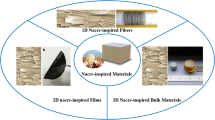Abstract
Nacre (mother of pearl) is an attractive model for the development of new materials. Its sheet structure of alternating layers of calcium carbonate and an organic matrix confers it highly desirable properties such as high toughness and strength. In this study, we produce a nacre-inspired composite material using only bacterially-produced components. Calcium carbonate is crystallized via the action of ureolytic bacteria. After each crystallization event, we apply bacterially produced γ-polyglutamate (PGA) to the sample, which promotes layering compared to the PGA-free control. We show that the combination of these two compounds yields a layered material reminiscent of nacre, showing a way towards the biotechnological production of new, nacre-inspired materials.
Similar content being viewed by others
References
M. A. Meyers, P.-Y. Chen, A. Y.-M. Lin, and Y. Seki, Prog. Mater. Sci. 53 (1), 1 (2008).
J. Sun and B. Bhushan, RSC Adv. 2 (20), 7617 (2012).
J. Wang, Q. Cheng, and Z. Tang, Chem. Soc. Rev. 41 (3), 1111 (2012).
I. Corni, T. J. Harvey, J. A. Wharton, K. R. Stokes, F. C. Walsh, and R. J. K. Wood, Bioinspiration Biomimetics 7 (3), 31001 (2012).
S. Deville, E. Saiz, R. K. Nalla, and A. P. Tomsia, Science 311 (5760), 515 (2006).
P. Das, J.-M. Malho, K. Rahimi, F. H. Schacher, B. Wang, D. E. Demco, and A. Walther, Nat. Commun. 6 (2015).
F. Hammes and W. Verstraete, Rev. Environ. Sci. Biotechnol. 1 (1), 3–7 (2002).
M. P. Harkes, L. A. van Paassen, and V. S. Whiffin, Geomicrobiol. J. 24 (5), 417 (2007).
L. A. van Paassen, R. Ghose, T. van der Linden, W. van der Star, and M. van Loosdrecht, J. Geotech. Geoenviron. Eng. 136 (12), 1721 (2010).
S. S. Bang, J. K. Galinat, and V. Ramakrishnan, Enzyme Microb. Technol. 28 (4–5), 404 (2001).
K. L. Bachmeier, A. E. Williams, J. R. Warmington, and S. S. Bang, J. Biotechnol. 93 (2), 171 (2002).
S. Makino, I. Uchida, N. Terakado, C. Sasakawa, and M. Yoshikawa, J. Bacteriol. 171 (2), 722 (1989).
F. B. Oppermann-Sanio and A. Steinbüchel, Naturwissenschaften 89 (1), 11–22 (2002).
J. M. Buescher and A. Margaritis, Crit. Rev. Biotechnol. 27 (1), 1 (2007).
A. Sugawara and T. Kato, Chem. Commun. (6), 487 (2000).
H. Jiang, L. Shang, S. Yoon, S. Lee, and Z. Yu, Biotechnol. Lett. 28 (16), 1241–1246 (2006).
M. Ashiuchi, K. Soda, and H. Misono, Biochem. Biophys. Res. Commun. 263 (1), 6 (1999).
G. Kedia, D. Hill, R. Hill, and I. Radecka, J. Nanosci. Nanotechnol. 10 (9), 5926 (2010).
B. Manocha and A. Margaritis, Biotechnol. Prog. 26 (3), 734 (2010).
H. Gao, B. Ji, I. L. Jäger, E. Arzt, and P. Fratzl, PNAS 100 (10), 5597 (2003).
Author information
Authors and Affiliations
Corresponding authors
Rights and permissions
About this article
Cite this article
Schmieden, D.T., Meyer, A.S. & Aubin-Tam, ME. Using bacteria to make improved, nacre-inspired materials. MRS Advances 1, 559–564 (2016). https://doi.org/10.1557/adv.2016.150
Published:
Issue Date:
DOI: https://doi.org/10.1557/adv.2016.150




